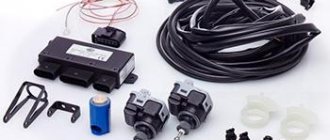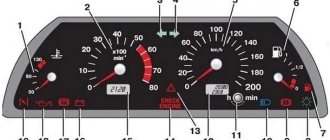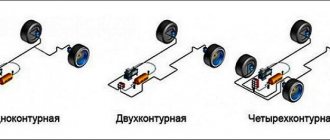Operating principle
The corrector is designed to adjust the level of the cut-off line in low beam headlight mode. For the long-range glow mode, this option is not so important, since only the low beam headlights have a clear cut-off line (the conventional border of the light flux, abruptly turning into a practically unlit area). The low beam of the headlights should illuminate the road well, but not dazzle oncoming drivers.
The level of the cut-off line depends on the shape and vertical angle of the reflector. It is the last parameter that needs constant adjustment, since the angle of the headlights depends on the degree of load and distribution of cargo in the car. The more the rear part is loaded, the more the front of the car will be raised. Accordingly, even correctly adjusted headlights will now blind drivers of oncoming cars.
According to the requirements for cars manufactured in Europe, all cars approved for operation after 1999 must be equipped with a headlight leveler as standard. Such systems are not installed on cars with active suspension.
Enforcement systems
The headlight range control is controlled by changing the position of the switch on the dashboard. The main types of drives used in the design of manual correctors:
- mechanical. The design can only be called a headlight corrector, since the device is an adjusting screw mounted in the headlight housing. Screwing or unscrewing the latter leads to a change in the vertical angle of inclination of the reflector;
- hydromechanical;
- electromechanical;
- pneumatic. Due to its complexity, the pneumatic headlight leveler has gained little popularity. The system can have manual or automatic adjustment. In the first case, the pneumatic actuators are controlled by the driver via an n-position switch on the dashboard (most often used in conjunction with halogen lighting). The operation of the automated system involves body position sensors, a control unit, and actuators (used in conjunction with xenon lamps). The position of the reflector is regulated by changing the air pressure in the corresponding lines.
Hydrocorrector
This system is well known to domestic car enthusiasts, since manual headlight levelers of this type were installed on VAZ 2107, 2109, 2110, 2114, Niva, and Granta.
Main components of the system:
- 6 – knob for adjusting the light beam;
- 1 – main adjustment mechanism;
- 2 – working cylinders with a rod acting on the headlight reflector.
The operating principle is based on adjusting the position of the corrector rod by moving a special fluid along the lines. The switch is mechanically connected to the piston of the main hydraulic cylinder. When the regulator handle is operated to raise the reflectors, the fluid pressure in the system increases, which drives the working cylinders, thereby extending the rod. Since the system is completely sealed, moving the handle back has the opposite effect.
The archaic system is considered extremely unreliable. Over time, the joints of the tubes and cuffs lose their tightness, which leads to air being sucked into the system and loss of working fluid.
Electromechanical corrector
The electrically driven headlight reflector adjustment system has become the most widespread. The electric drive allows for both forced change in the height of the light beam boundary and automatic adjustment depending on actual driving conditions.
What determines the choice of the value of the corrector regulator?
The regulator has several positions - from 0 to 3. It is necessary to remember: the more the machine is loaded, the higher the number on the regulator should be. That is, 0 is an empty car (only the driver is sitting in it, the trunk is empty), and 3 is a loaded car (several passengers are sitting in it, the trunk is full). To navigate the controller values, you can refer to the following setting rules:
- position 0 - driver only;
- position 1 - all passenger seats are occupied;
- position 2 - all passenger seats are occupied and the trunk is slightly loaded;
- position 3 - all passenger seats are occupied, the trunk is fully loaded, or a loaded trailer is being towed.
Automatic headlight control systems
The automated headlight reflector position corrector does not require driver participation to adjust the cut-off line. The system used with halogen lamps is based only on the position of the body, which is why it is also called static.
On vehicles with xenon light sources, an advanced adaptive corrector is used that maintains the light beam in a given position, focusing on changes in body position when accelerating, decelerating, changing direction and driving on bumpy road sections. This is determined by the fact that the direct light of xenon headlights has a much more aggressive effect on human eyes.
System design:
- vehicle ride height sensors;
- Control block;
- servo drives (conventional electromechanical gear motors).
Sensor from the kit for installing xenon yourself.
The operating principle is based on the constant reading of the vehicle's ground clearance. For this purpose, non-contact sensors based on the Hall effect are used. Typically, several sensors are installed on load-bearing body elements in the front and rear parts. The meter body contains a stator (moving element) with built-in magnets and a rotor (fixed element), which is a Hall sensor. The stator is connected by a rod to the suspension part, so any change in the position of the part relative to the body is transmitted by the sensor to the control unit. The ECU processes the received information and controls the operation of the gearmotors. Despite the obvious convenience, the automatic corrector is often equipped with a system with the possibility of manual adjustment.
Why do you need a proofreader?
A headlight corrector is a device that allows you to adjust the direction of the light beam from the optics. You can find it on the side panel of the car. This device looks like an adjustment wheel that can be adjusted to several positions. Usually there are four such positions: from 0 to 3. Thanks to this wheel, you can change the direction of the light emanating from the headlights. The position of the regulator at number 3 allows you to lower the optics, at number 0 - to raise it.
Modern cars may not have such a corrector, since they are equipped with an auto-corrector. This device detects how loaded the car is and automatically adjusts the direction of the headlights. However, this system does not always work correctly.
What is it and how does headlight range control work?
This is a device that maintains the set position of the optical axis of the headlight unchanged when the load and driving conditions of the vehicle change.
The light generated by the vehicle's optics is adjusted when the vehicle is unloaded and is highlighted in yellow in the above figure. However, the luminous flux changes depending on the load of the car, shifting up or down from the correct optical axis, which is shown in red in the figure. To correct such a change, the headlight range control is used.
Some historical information
Legislative aspect
Of course, such a useful device should have been installed on all cars as soon as it was invented. However, this was only seriously considered in 1990. And naturally, the Germans were pioneers in many issues in the automotive industry. It was the German government that adopted a decree that the corrector must be installed on every car. And only eight years later this norm comes to European countries. The only exceptions were cars that had active suspension installed.
The process of introducing the corrector into production processes
In fact, correctors for cars initially appeared a little earlier. Since the 50s, most luxury cars have had this mechanical device. Drivers of other cars made do with a manual corrector.
Manual correctors were popularly called static regulators. But they had limited capabilities: the position of the headlights could only be changed immediately before the trip. In other words, if the car was loaded, that is, its rear part sagged, and the front part rose up, it was necessary to change the angle of the headlights.
Since the seventies, static correctors have undergone modernization. A regulator was invented that changes the position of the headlights from the interior.
In their design, the improved correctors had remote drives and their operation process was based on one of the following systems:
- vacuum;
- electric;
- pneumatic;
- hydraulic.
After some changes and modifications, electromechanical mechanisms began to enjoy great demand and popularity. However, they soon became ineffective, since without special instruments it is impossible to determine the angle by which the light source should be deflected.
Correct headlight adjustment
Precise adjustment of headlights has a huge impact on driving safety at night, because... The traffic flow on modern roads is quite large. Every car enthusiast should know the basic principles of this process.
The adjustment is made as follows. A screen is installed perpendicular to the floor plane, with special markings, on which the main reference point is the broken line for adjusting the light of car headlights.
Certain requirements must be met in order for the final result to be correct, we list them below:
- All car tires must be the same. The pressure should also be checked and adjusted if necessary. At the final stage, the load on the driver’s seat should be taken into account so that it corresponds to its weight category.
- The manual range controls should be in the zero position corresponding to an unloaded vehicle.
- The car should be placed in such a way that the axis of the rear wheels is parallel to the screen, in other words, the axis of symmetry of the car should coincide with the plane bisecting the distance between the headlights. The accuracy and correctness of the adjustment will directly depend on how the car is installed.
In general, with the help of lighting angle correctors, the convenience and safety of driving at night significantly increases. This wonderful device has already prevented many accidents and saved thousands of human lives, and will prove its benefits more than once.
Mercedes made a driverless bus of the future (video)
Two years ago, Mercedes presented the concept of the Future Truck 2025, which will be equipped with an autopilot system that allows the truck to maintain speeds of up to 85 kilometers per hour. Not long ago, this technology was adapted for city driving and added to the Future Bus, which will be able to accelerate.
What kind of lighting do you prefer?
Built-in Chandelier
Russian Toyota RAV4 received a special package
And they were completely justified. Toyota has decided to start installing a navigation system with Yandex maps not only on Camry sedans, but also on RAV4! For now, such navigation with the ability to plot routes taking into account traffic jams will be available only on cars in the Exclusive configuration with a new multimedia system based on Android with an 8-inch display and a DVD player (and also such cars.
Thus, the court upheld the appeal of representatives of the movement, who insisted that they were not notified of the court hearing at which the Ministry of Justice’s claim for liquidation was considered, RIA Novosti reports. The leader of the StopHam movement, Dmitry Chugunov, called the decision of the Supreme Court “a triumph of justice and common sense” and said that he was waiting for the legal entity to be restored.
Another road trap discovered in Moscow
In the parking lots located in 4th Dobryninsky Lane, the stickers with paid parking numbers on information signs have been changed. However, as one of the members of the Blue Buckets group on Facebook found out, the new numbers do not correspond to the real parking number, which can lead to a fine for unpaid parking. Let us note that this is not the first case.
Expert opinion
It-Technology, Electrical power and electronics specialist
Ask questions to the “Specialist for modernization of energy generation systems”
Headlight corrector: how it works, how to properly install a headlight corrector with your own hands It is difficult to accurately determine the list of the most stolen cars, since each insurance company or statistical bureau has its own information. Ask, I'm in touch!
Light adjustment process
The process of adjusting the power of the light flux is as important as correct adjustment of the direction of the light. Here everything needs to be done very subtly, because even a very bright high beam can cause a lot of inconvenience to the driver ahead, even though it seems that he is at a decent distance. To avoid such consequences, there is a special light stand that is used to adjust the power and direction of the light flux. In order to adjust everything, you need a flat screen, which will be installed strictly perpendicular to the floor level. The screen should contain several marks:
- at the place where the center of both headlights should be approximately, there are vertical lines (VV);
- at the height of the center - H;
- horizon lines RR;
- slightly below both R's and to the left of both V's are horizontal lines designated as D.
After all procedures, the broken straight line CC should be clearly visible. It will be taken as the basis for regulating the power of the beam flow.
When adjusting the light flux, it is initially necessary that the same tires are installed on the car. And also the pressure in them should be set to the same. Next, the load on the driver’s seat with a real mass must be simulated.
After all the manipulations, you need to act according to the following principle:
- Place the car's rear axle parallel to the screen.
- Move the regulator to the “zero” position.
- Cover one of the headlights with a special flap.
- Adjust one headlight, and then carry out all the steps with another car light source.
Next, the following actions are performed: the low beam boundary is aligned with the CC line. However, it is not always possible to set this position accurately. The same thing happens with a manual corrector. In addition to boundaries and lines, it is not always possible to correctly and levelly install even a car, and also for correct adjustment you need a long darkened box or some kind of room.
Today, specialists have developed the latest devices that can quickly and efficiently adjust the corrector and level the light flux.











